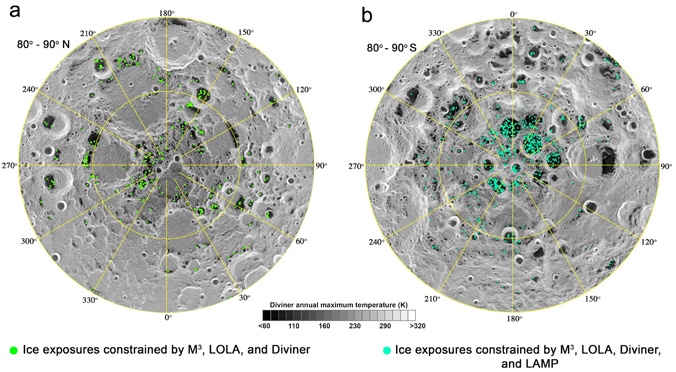Shadows have been known throughout history to be excellent hiding places. They may even be hiding unexpected things off the Earth as well. According to a new NASA study, there might be water that moves from shadow to shadow on the moon – even in daylight.
Scientists have long accepted the fact that there is water on the moon – especially in the permanently shadowed craters at the poles, which is part of the reason they recently funded a “hopper” mission to go investigate. But there are parts of the Moon that are sometimes exposed to the sun, and sometimes cloaked in shadow. Previously, scientists thought it would have been difficult for water ice to exist in these environments, but it turns out they might have been wrong.
Data from SOFIA, one of NASA’s airliner-based observatories, confirmed that water does exist on the surface of the moon exposed to daylight. But models suggested that any water that might have existed there should have been burned away by the Sun. There was one critical hint in the data, which then led to a hypothesis leveraging two other factors in the lunar environment.
That critical hint was that the amount of water measured by SOFIA decreases in the lunar “morning” and then increases in the lunar “afternoon”. If it was simply being burned away, the amount would have steadily decreased throughout the time. It also ruled out the water being trapped in rock formations by a previous meteor impact. But one explanation that fit the data is that the water is migrating to different parts of the moon throughout the course of a lunar day. To figure out if that was possible, scientists at the Jet Propulsion Laboratory started to look at lunar environmental conditions.

Credit – Shuai Li, University of Hawaii SOEST/ HIGP
One focal point of their study were the “jagged” shadows that lay across the lunar surface and move with the sun’s position in the sky. These shadows are primarily formed by rocks or cliffs rather than crater walls, and usually aren’t very big. While the sun blasts these areas it dramatically increases their temperature, up to 120° C in some cases. After the sun moves on and an area is again cast into shadow, the temperature can go down to -210° C. Heat is not transferred between these two areas effectively, even though they might be literally touching each other, as there is little to no atmosphere to provide the thermal conductance necessary to even out temperatures, like there is on Earth.
Pockets of water ice are certainly possible at those frigid temperatures in shadow, but what about the change in amount over the course of a lunar day? Though there isn’t enough atmosphere to perform thermal transfer on the moon, there might be enough to perform hydro transfer.

Credit – NASA / JPL-Caltech
Despite the common perception of the Moon being a completely airless desert, it does have an “exosphere” which is composed of trace amounts of gasses that are gravitationally bound to the lunar surface before they are blasted away by solar winds. Water ice that is frozen into shadowy areas which are then exposed to sun would presumably join this exosphere as vapor, and could transfer to a colder, shadow covered area, and then refreeze as part of the lunar day cycle.
That all sounds good in theory, but so far that is just theory. So the JPL team decided to design a sensor that could help collect data to prove or disprove that theory. Known as the Heterodyne OH Lunar Miniaturized Spectrometer (HOLMS), this diminutive sensor would actually look for hydroxyl, which is similar to water, and can likely provide insight into how much water there is in the exosphere. Hydroxyl is much more reactive than water, making it an easier target for quantifying sensors, like HOLMS.
Unfortunately, time might be running out for the use of such sensors. Efforts are already ongoing to establish permanent and commercial operations on the moon, and any such efforts carry the risk of adding artificial water vapor or other contaminants to the otherwise pristine lunar surface. Luckily, the sensors are already outfitted for use on some lunar landers, such as the Autonomous Pop-Up Flat Folding Explorer Robot (A-PUFFER), that could serve as the vanguard of any human missions to the moon.
Until any such sensor is launched though, all we have is remote observations and theory to go by. But if there’s one lesson to learn from all of this it is to stay away from shadows on the moon – it’s really, really cold there, and you could also slip on some ice.
Learn More:
JPL – NASA Study Highlights Importance of Surface Shadows in Moon Water Puzzle
RAS – Implications of surface roughness in models of water desorption on the Moon
UC Boulder – Tiny moon shadows may harbor hidden stores of ice
SciTech Daily – NASA Says Cold Shadows on the Lunar Surface Can Explain Moon Water Mystery
Lead Image:
Apollo era image of an astronaut on the moon.
Credit – NASA

